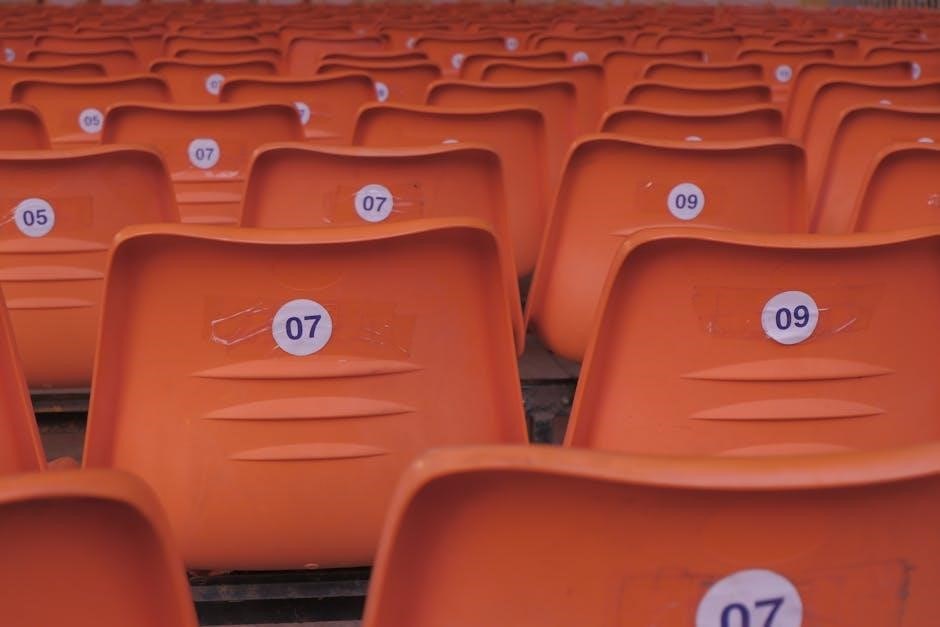ASCE/SEI 7-05: Minimum Design Loads
ASCE/SEI 7-05‚ titled “Minimum Design Loads for Buildings and Other Structures‚” is a crucial standard referenced within U․S․ building codes․ This standard specifies the minimum design load requirements necessary for ensuring structural safety and integrity in various construction projects nationwide․
Overview of ASCE/SEI 7-05
ASCE/SEI 7-05 provides comprehensive guidelines for determining minimum design loads for buildings and structures‚ serving as a cornerstone for structural engineering practice in the United States․ This standard meticulously outlines requirements for various load types‚ including dead loads‚ live loads‚ wind loads‚ snow loads‚ seismic loads‚ and flood loads‚ ensuring structural designs adequately address potential environmental and operational stressors․
It’s an essential resource for engineers‚ architects‚ and building officials‚ promoting safety and resilience in the built environment․ ASCE/SEI 7-05 is integrated into building codes‚ ensuring consistent application of structural design principles․ It directly impacts the design process‚ influencing material selection‚ structural configurations‚ and construction practices․
The document also uses both Système International (SI) units and customary units․ This comprehensive document is essential for engineers ensuring safety and compliance․
Replacement of ASCE 7-98
ASCE/SEI 7-05 superseded and replaced ASCE 7-98‚ marking an evolution in structural design standards․ This transition incorporated updated research‚ improved methodologies‚ and lessons learned from real-world events‚ enhancing the accuracy and reliability of load calculations․ The updated standard introduced refined procedures for determining wind loads‚ seismic loads‚ and other critical design parameters․
The changes aimed to improve structural safety and resilience‚ reflecting advancements in engineering knowledge and construction practices․ By replacing ASCE 7-98‚ the newer standard ensured that structural designs were based on the most current and comprehensive understanding of potential loads and their impact on buildings and structures․
The move to ASCE/SEI 7-05 signified a commitment to continuous improvement in structural engineering‚ incorporating the latest findings and best practices to safeguard the built environment․ It ensures designs are up-to-date with current safety measures․

Key Aspects of ASCE/SEI 7-05
ASCE/SEI 7-05 encompasses crucial aspects of structural design‚ including wind load criteria‚ seismic load provisions‚ and load combinations․ These elements are essential for ensuring the safety and stability of buildings and other structures under various environmental conditions․
Wind Load Criteria
ASCE/SEI 7-05 dedicates significant attention to wind load criteria‚ providing detailed guidelines for assessing and mitigating the effects of wind on structures․ These criteria are essential for engineers to design buildings capable of withstanding extreme wind events‚ ensuring the safety of occupants and the integrity of the structure․
The standard outlines various procedures for determining wind loads‚ considering factors such as building height‚ shape‚ location‚ and surrounding terrain․ It incorporates analytical methods for calculating wind pressures on different building surfaces‚ accounting for both positive and negative pressures․ ASCE/SEI 7-05 also addresses specific considerations for components and cladding‚ ensuring that these elements are adequately designed to resist wind forces․
Moreover‚ the standard provides guidance on addressing wind-borne debris‚ a significant hazard during hurricanes and other severe windstorms․ This includes requirements for impact-resistant windows and doors‚ as well as strategies for protecting vulnerable building components from damage caused by flying debris․ These comprehensive wind load criteria are crucial for creating resilient structures that can withstand the challenges posed by wind events․
Seismic Load Provisions
ASCE/SEI 7-05 includes comprehensive seismic load provisions that are critical for designing structures in seismically active regions․ These provisions aim to minimize the risk of structural damage and collapse during earthquakes‚ thereby protecting lives and property; The standard incorporates the latest research and engineering practices to provide a robust framework for seismic design․
The seismic load provisions in ASCE/SEI 7-05 address various aspects of earthquake engineering‚ including site-specific ground motion analysis‚ structural system selection‚ and detailing requirements․ It defines procedures for determining seismic base shear‚ which is the total horizontal force used to design a structure’s resistance to earthquake forces․ The standard also provides guidance on calculating seismic load effects‚ considering factors such as soil conditions‚ building period‚ and occupancy category․
Furthermore‚ ASCE/SEI 7-05 specifies detailing requirements for different structural materials‚ such as concrete‚ steel‚ and masonry‚ to ensure that they can withstand the cyclic loading imposed by earthquakes․ These provisions are essential for creating ductile structures that can deform without collapsing‚ thereby enhancing their resilience during seismic events․ The document also uses design spectral acceleration parameters․
Load Combinations
ASCE/SEI 7-05 outlines crucial load combinations that structural engineers must consider during the design process․ These load combinations account for the simultaneous action of various loads‚ such as dead loads‚ live loads‚ wind loads‚ snow loads‚ and seismic loads‚ to ensure the structure can safely withstand all potential loading scenarios throughout its lifespan․ The standard provides specific equations and factors to determine the appropriate load combinations based on the building’s occupancy‚ location‚ and structural system․
The load combinations in ASCE/SEI 7-05 are designed to represent the most critical loading conditions a structure might experience․ By considering various load scenarios‚ engineers can design structures with adequate strength and stability․ The standard distinguishes between service-level load combinations‚ used for evaluating deflections and vibrations‚ and strength-level load combinations‚ used for determining the required structural capacity․ These combinations also ensure structural safety and reliability․
Furthermore‚ ASCE/SEI 7-05 specifies load factors that are applied to each load type within a combination․ These factors account for uncertainties in load magnitudes and variations in material properties‚ providing an additional margin of safety․ The application of appropriate load combinations is essential for ensuring the structural integrity and durability of buildings and other structures․ The IBC 2012 follows these combinations as well․

Specific Chapters and Sections
ASCE/SEI 7-05 is organized into specific chapters and sections‚ each addressing distinct aspects of minimum design loads․ These sections provide detailed requirements and guidelines for various load types and structural considerations‚ ensuring comprehensive coverage․
Chapter 13: Minimum Design Loads
Chapter 13 of ASCE/SEI 7-05 specifically addresses the minimum design loads required for buildings and other structures․ This chapter outlines essential considerations for determining appropriate load factors‚ ensuring structural integrity under various conditions․ Key aspects covered include the component importance factor‚ which plays a crucial role in assessing the relative significance of different structural elements․
Chapter 13 provides guidance on evaluating and applying these factors to ensure the structural safety of buildings and infrastructure․ By adhering to the guidelines outlined in Chapter 13‚ engineers and designers can effectively mitigate risks associated with various load scenarios․
Moreover‚ this chapter emphasizes the importance of considering all relevant load combinations to ensure that structures can withstand the combined effects of different forces․ This holistic approach to load assessment is essential for preventing failures and ensuring long-term structural performance and safety․ This chapter also provides formulas for calculating seismic loads and load combinations․
Section 11․4․4: Design Spectral Acceleration Parameters
Section 11․4․4 of ASCE/SEI 7-05 focuses on the “Design Spectral Acceleration Parameters‚” which are vital for seismic design; This section provides detailed guidelines for determining the design earthquake spectral response acceleration parameter at short periods‚ denoted as SDS‚ and at a 1-second period‚ denoted as SD1․ These parameters are crucial for assessing the seismic hazard at a specific site and are essential inputs for calculating seismic loads on structures․
The section references maps prepared by the United States Geological Survey (USGS) in collaboration with FEMA․ These maps provide valuable data for determining the appropriate SDS and SD1 values based on the site’s geographic location and soil conditions․ Utilizing these parameters‚ engineers can accurately estimate the expected ground motion during an earthquake and design structures that can withstand these forces․

Furthermore‚ Section 11․4․4 ensures that seismic design calculations are based on the best available scientific data‚ enhancing the safety and resilience of buildings and infrastructure in seismically active regions․ It emphasizes the importance of accurate site-specific analysis to account for local geological conditions․

Errata and Supplements
ASCE/SEI 7-05‚ like other standards‚ has errata and supplements․ These documents provide clarifications‚ corrections‚ and updates to the original standard․ Accessing these materials ensures accurate application of the standard’s provisions for design and construction practices․
Availability of Errata
Errata for ASCE/SEI 7-05‚ “Minimum Design Loads for Buildings and Other Structures‚” are typically made available by the American Society of Civil Engineers (ASCE)․ These errata address errors‚ inconsistencies‚ or ambiguities discovered after the initial publication of the standard․ Such information is vital for engineers and construction professionals to ensure accurate interpretation and application of the standard․
To access these errata‚ interested parties should visit the ASCE website‚ specifically the section dedicated to standards and publications․ The errata are usually provided in PDF format for easy downloading and reference․ Users can also find announcements and notifications regarding the availability of errata through ASCE’s publications‚ newsletters‚ or professional forums related to structural engineering and building codes․
It is crucial for practitioners to regularly check for errata and incorporate them into their design practices to maintain compliance with the most up-to-date version of the ASCE/SEI 7-05 standard‚ ensuring the safety and reliability of buildings and other structures․
Supplements to ASCE/SEI 7-05
Supplements to ASCE/SEI 7-05‚ “Minimum Design Loads for Buildings and Other Structures‚” are additional documents that provide updates‚ revisions‚ or clarifications to the original standard․ These supplements address emerging issues‚ incorporate new research findings‚ and refine existing provisions to improve the accuracy and applicability of the standard․
ASCE publishes supplements to ensure that the standard remains current with the latest advancements in structural engineering and construction practices․ Supplements are typically released periodically and may cover various aspects of the standard‚ including wind loads‚ seismic loads‚ snow loads‚ and load combinations․
These supplementary materials are essential resources for engineers‚ architects‚ and building officials who rely on ASCE/SEI 7-05 for structural design and code compliance․ Supplements are generally available for purchase or download from the ASCE website‚ often in PDF format; Users should always refer to the latest supplements in conjunction with the base standard to ensure they are using the most accurate and up-to-date information․